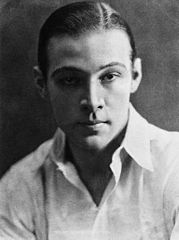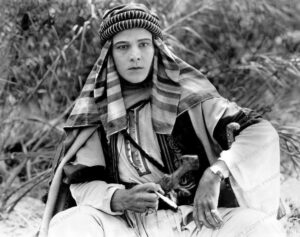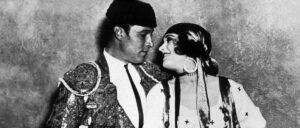Rudolph Valentino – the Myth of the Passionate Southerner

Rudolph Valentino was the first great amante of world cinema. A native of Italy, the young dancer went down in the history of the silver screen as the creator of the myth of the passionate southern man – a man of compelling charm that no woman could resist. The legend of the actor was based on the unusual combination of the ideal of masculinity with the helplessness of a young boy.
The difficult beginnings of Valentino’s career
Rudolph Valentino (Rodolfo Alfonso Raffaello Piero Filiberto Guglielmi di Valentina d’Antoguolla) was born in Italy (Castellaneta) in 1895. In his native country he briefly attended an agricultural school and from childhood he was most attracted to dance. He therefore went to Paris and then to the USA to pursue his artistic development there. It quickly became clear that the life of an emigrant in the United States was a hard slice of bread.
At the beginning of the second decade of the twentieth century, America became fashionable for an exotic dance – tango. So Rudolph Valentino employed himself in several clubs in New York as a stage dancer. He also earned a living as a dishwasher and happened to sleep on a park bench. At the same time, the young Italian tried his hand at cinema; in the first three years of his stay in the U.S. he participated in twenty films, but did not achieve any success. The key to his career, however, turned out to be his extraordinary appeal, which attracted the attention of women associated with the film industry, and they enabled him to enter the salons.

Valentino-amant
One of the first to meet Valentino was Jean Acker, an American actress of silent cinema. In unexplained circumstances, she simply married a beautiful dancer, but immediately after the wedding ran away from him. The decision of the star was supposedly influenced by her lesbian sexual orientation. This event drew the attention of Rudolph Valentino, who soon, thanks to June Mathis, the head of the script department at Metro Pictures, got a role in his first big film – “The Four Horsemen of the Apocalypse”. At that time Natacha Rambova, a friend of Alla Nazimova, fell in great love with the young actor, thanks to which the actor appeared alongside Nazimova in “Camille”. Valentino married Rambova and for a time was even a bigamist (because at the same time he was still married to Jean Acker). Nevertheless, the second wife, like the first, abandoned the actor. Another famous love of the actor was Pola Negri herself.
A telling symbol of Valentino and his attitude to women became the famous “slave bracelet”. The actor got it from Natasha Rambova and wore it to the outrage of journalists. For this he was despised – for American men he became a symbol of an effeminate man who allows women to get into his head, and his image differs from the common image of a rough and uncouth masculinity.
Rudolph Valentino and films creating a new type of masculinity
Films with Rudolph Valentino created a new type of masculinity. In his next famous roles in “The Sheik”, “Blood and Sand”, “The Young Rajah” or Cobra Valentino created an innovative, for those times, acting creation. As a film hero, he definitely stood out from the popular actors of the time, such as Douglas Fairbanks. In contrast to the tough guy type of cowboy, pirate, Zorro, or Robin Hood, Valentino embodied an immature masculinity, a swashbuckling, romantic boy who can die for love. In the times just after the First World War, women no longer swooned at the sight of a male soldier, but wanted everything that contradicted brutality and aggressiveness. Thus the embodiment of dreams was a beautiful Rudolph Valentino with a flirtatious look, a Latino lover, a man full of passion and at the same time a boy who could be tenderly taken care of.

Rudolph Valentino and Pola Negri
Interestingly, the phenomenon of Valentino’s popularity among the audience prompted the cinema makers to conduct the first sociological research on the audience’s tastes. It turned out that Valentino’s audience was, of course, mainly women, who could watch the same film with the leading ladies’ man several times. This group was dominated by young girls, unmarried women and housewives.
It is also worth noting that Valentino was something of a phenomenon in American culture. His popularity peaked at a time of widespread American dislike of immigrants, especially from Italy. Meanwhile, this Latino actor not only won the hearts of the public, but also contributed to the fascination with otherness. For he played exotic characters from remote corners of the world.
Rudolf Valentino – tragic biography
The myth of Rudolph Valentino also includes the untimely death of the actor, who died as a result of complications after gastric ulcer surgery, at just 31 years old. The actor’s death occurred in New York in 1926. On the news of the actor’s death, there were supposed to be cases of suicide among his female fans. Valentino remained in the memory of the public that idolized him eternally beautiful and young.
The anti-myth of Valentino
In addition to the legend of the famous lover boy, an anti-myth of Valentino also emerged. There is much to suggest that the actor was homosexual and despite reports of numerous affairs with women, he never actually slept with them. What’s more, during Valentino’s divorce trials there were threads of his impotence. In addition, despite earning millions, Valentino was said to have left behind such huge debts that there was not even enough money to arrange his funeral. What was it really like with one of the most famous amateurs of cinema? No one will settle this now – for some, he will always remain the embodiment of women’s longings, an ideal lover with a romantic soul, for others he will remain only a posed product of Hollywood.
Sources:
Z. Pitera, Miłe kina początki, Warsaw 1979.
A. Jackiewicz, Gwiazdozbiór / Stardust, Warsaw 1983.
A. H. Petersen, Scandals of Classic Hollywood: Sex, Deviance, and Drama from the Golden Age of American Cinema”, 2014.
